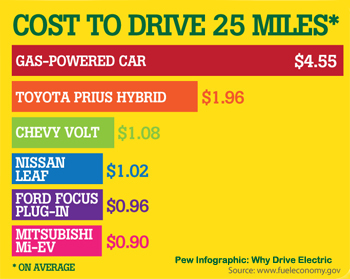Tesla's repayment of a Department of Energy loan nine years ahead of schedule is welcome news and another indication that use of electric vehicles is growing -- both here and around the globe. Domestic sales of these automobiles tripled between 2011 and 2012, with more than 100,000 sold. Hybrid and plug-in vehicles accounted for almost 4 percent of total new car purchases in the United States. The International Energy Agency projects that, worldwide, there could be 20 million electric vehicles on the road by 2020. This is great progress. But there is more work to do to assure that EVs are part of our clean energy future -- and many reasons why we need to succeed.
To begin with, increased sales of battery-powered and hybrid autos such as the Tesla help confirm that a healthy environment can strengthen the economy and spur exports. According to the Department of Energy, the advanced battery sector will grow to $50 billion annually by 2020. And as the global auto market reaches 2 billion by mid-century -- up from 700 million today -- the manufacture and sale of electric vehicles are certain to constitute a substantial portion of this international trade.
Tesla's success also demonstrates the essential role of private-public partnerships in fostering innovation and bringing new products to market. For example, the cost of an advanced battery has fallen more than 50 percent since 2008 because of the Department of Energy's investment in this technology. Similarly, pilot programs supported by local and state governments have increased the number of charging stations to more than 17,000 across the United States. As the number of stations grow the incentive to innovate does too.
Public-private partnerships are important for another reason: they help level the playing field with gasoline powered cars. Congress provided a $7,500 federal tax credit for the purchase of electric vehicles. Coupled with state and local incentives and fuel savings of up to $200 per month, the cost of these vehicles is comparable to conventional automobiles.
Long an innovation leader, the Department of Defense is getting in on the act too. Oil costs the military $16 billion a year. So the department has begun a pilot program where it will use up to 500 electric vehicles at six U.S. bases and maximize the value by selling power back to the grid during peak daytime hours. The Pentagon anticipates realizing from $2,000 up to $9,000 annually for each vehicle depending on vehicle and battery size.
The electric vehicle market will continue to grow. In early June, business leaders gathered at the Silicon Valley Leadership Group's Driving Charged and Connected 2013 conference to discuss not whether the use of this technology will increase, but when and how. SAP, Schneider Electric, General Electric, and Google, which has the largest corporate electric vehicle charging infrastructure in the country with 400 charging stations, were just a few of the technology leaders present. While each of these companies has a stake in the success of electric and hybrid vehicles, they may be slower to invest in this technology unless the United States leads the way with clear, consistent national policies that offer certainty for businesses and affordable prices for consumers.
To that end, the Department of Energy set a goal to help electric vehicles achieve cost parity without incentives by 2022, primarily through increased investment in energy research and development. But the federal government can -- and should -- do more. In addition to expanding early-stage research, the United States can secure leadership in this sector by promoting innovative pilot programs at the state and local level to help industry test and deploy new electric vehicle technologies and business models.
These kinds of common sense investments will keep the United States the world leader in clean energy and modern, efficient, and low cost transportation. And that is exactly the future we should be striving for.

